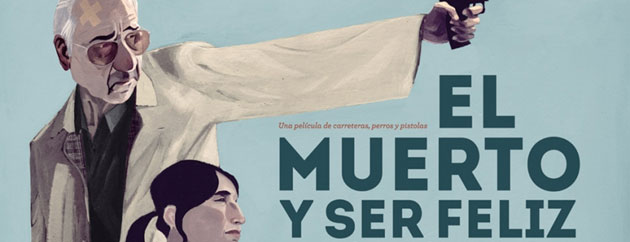
The Dead Man and Being Happy
05 December, 2012The Dead Man and Being Happy (El Muerto y Ser Feliz) is the third feature film from Spanish writer and director Javier Rebollo, and charts the somewhat unconventional road-trip of its two curious yet strangely endearing protagonists.
The film begins with a descriptive narration which sets the tone for the rest of the film. With the concentration on the seemingly banal details of the film as well as the main action of the plot, these descriptive narrations are almost reminiscent of closed captioning for the blind, or of stage directions which were never meant to be read aloud, and serve to draw the viewer in to look more closely at the film, to appreciate the small details that would perhaps otherwise go unnoticed.
Closed caption audio for the blind is often described as a way to ‘see with sound’ and this is certainly what the viewer does, for the film owes a lot to its soundtrack and its subtle use of chops and changes in music, narration and sound effects.
The film follows the story of Santos, an aging Spanish hit man, on a journey not so much of discovery but of acceptance. His journey takes him through northern Argentina, picking up a younger but equally wayward companion, Erika, early on in the film. Eventually, and perhaps predictably, after many hours on the road, the travelling companions become lovers and open up to each other about their respective pains, both physical and emotional.
As the narration tells us in one of its more poetic moments: Erika is running from a memory, and Santos from a man who hired him for a job he hasn’t done. This becomes a theme throughout the film, with the omniscient narrator reminding us at several points that Santos has unfinished business, that he is running from an incomplete task: Santos has left the latest of his targets alive, and taken off with the money nevertheless. Perhaps this goes someway to explaining the feeling of incompleteness that overshadows the whole adventure; Santos is really on a mission to find something he’s never found in life before, and to find whatever that may be before his time is up.
Santos, as we learn early on in the film, is living with the effects of three malignant tumours, one of them in his brain, though as he himself says ‘that one isn’t so bad’. The plot, as one can imagine, makes this a fairly bleak viewing at times, although it is still quite rightly marketed as a black comedy due to the film’s oddball moments and subtle quirks.
We learn that Santos is the Dead Man of the movies title, though however terminal and prophetic this may sound, Santos proves to be a man determined to find happiness in what could be his last moments, whether this comes with cheap drugs, pretty young nurses or on road-trip with no destination.
The Dead Man and Being Happy meanders through its plot at what could be described as a ponderous pace. However, we are jolted back into focus by sharp music cuts and by the often bizarre narration, which at times is out of kilter with the action of the plot, describing future events with certainty, only for them to transpire differently. Once again this shows us the importance of the narration in this film; our attention is frequently dragged back from the majestic Argentine scenery to the small details in the relationship of this oddball couple.
Those expecting a typical road-movie or a conventional hit-man thriller will be surprised or perhaps disappointed. We never actually get to see Santos kill anyone, the only victim of his gun being a wounded dog on an unnamed stretch of highway. The development of the film is somewhat slow moving, and is a more thought-provoking and intelligent road movie than many typical of the genre, which fill empty spaces with action and sex, rather than allowing for those genuine moments of reflection which make The Dead Man and Being Happy a standout film.
Follow Sounds and Colours: Facebook / Twitter / Instagram / Mixcloud / Soundcloud / Bandcamp
Subscribe to the Sounds and Colours Newsletter for regular updates, news and competitions bringing the best of Latin American culture direct to your Inbox.

